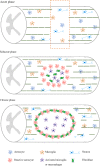Stem Cell Therapy for Spinal Cord Injury
- PMID: 33559479
- PMCID: PMC7876757
- DOI: 10.1177/0963689721989266
Stem Cell Therapy for Spinal Cord Injury
Abstract
Traumatic spinal cord injury (SCI) results in direct and indirect damage to neural tissues, which results in motor and sensory dysfunction, dystonia, and pathological reflex that ultimately lead to paraplegia or tetraplegia. A loss of cells, axon regeneration failure, and time-sensitive pathophysiology make tissue repair difficult. Despite various medical developments, there are currently no effective regenerative treatments. Stem cell therapy is a promising treatment for SCI due to its multiple targets and reactivity benefits. The present review focuses on SCI stem cell therapy, including bone marrow mesenchymal stem cells, umbilical mesenchymal stem cells, adipose-derived mesenchymal stem cells, neural stem cells, neural progenitor cells, embryonic stem cells, induced pluripotent stem cells, and extracellular vesicles. Each cell type targets certain features of SCI pathology and shows therapeutic effects via cell replacement, nutritional support, scaffolds, and immunomodulation mechanisms. However, many preclinical studies and a growing number of clinical trials found that single-cell treatments had only limited benefits for SCI. SCI damage is multifaceted, and there is a growing consensus that a combined treatment is needed.
Keywords: AD-MSCs; BM-MSCs; ESCs; EVs; NPCs; NSCs; U-MSCs; iPSCs; spinal cord injury; stem cells.
Conflict of interest statement
Figures

Similar articles
-
Stem Cell Transplantation: A Promising Therapy for Spinal Cord Injury.Curr Stem Cell Res Ther. 2020;15(4):321-331. doi: 10.2174/1574888X14666190823144424. Curr Stem Cell Res Ther. 2020. PMID: 31441733 Review.
-
hiPSC-derived NSCs effectively promote the functional recovery of acute spinal cord injury in mice.Stem Cell Res Ther. 2021 Mar 11;12(1):172. doi: 10.1186/s13287-021-02217-9. Stem Cell Res Ther. 2021. PMID: 33706803 Free PMC article.
-
Human Pluripotent Stem Cells for Spinal Cord Injury.Curr Stem Cell Res Ther. 2020;15(2):135-143. doi: 10.2174/1574362414666191018121658. Curr Stem Cell Res Ther. 2020. PMID: 31656156 Review.
-
Recent Progress in the Regeneration of Spinal Cord Injuries by Induced Pluripotent Stem Cells.Int J Mol Sci. 2019 Aug 6;20(15):3838. doi: 10.3390/ijms20153838. Int J Mol Sci. 2019. PMID: 31390782 Free PMC article. Review.
-
The role of mesenchymal stromal cells in spinal cord injury, regenerative medicine and possible clinical applications.Biochimie. 2013 Dec;95(12):2257-70. doi: 10.1016/j.biochi.2013.08.004. Epub 2013 Aug 27. Biochimie. 2013. PMID: 23994163 Review.
Cited by
-
Gelatin Methacrylic Acid Hydrogel-Based Nerve Growth Factors Enhances Neural Stem Cell Growth and Differentiation to Promote Repair of Spinal Cord Injury.Int J Nanomedicine. 2024 Oct 19;19:10589-10604. doi: 10.2147/IJN.S480484. eCollection 2024. Int J Nanomedicine. 2024. PMID: 39445156 Free PMC article.
-
Metformin enhances endogenous neural stem cells proliferation, neuronal differentiation, and inhibits ferroptosis through activating AMPK pathway after spinal cord injury.J Transl Med. 2024 Aug 5;22(1):723. doi: 10.1186/s12967-024-05436-9. J Transl Med. 2024. PMID: 39103875 Free PMC article.
-
Human induced pluripotent stem cell/embryonic stem cell-derived pyramidal neuronal precursors show safety and efficacy in a rat spinal cord injury model.Cell Mol Life Sci. 2024 Jul 29;81(1):318. doi: 10.1007/s00018-024-05350-9. Cell Mol Life Sci. 2024. PMID: 39073571 Free PMC article.
-
Functional recovery of a 41-year-old quadriplegic spinal cord injury patient following multiple intravenous infusions of autologous adipose-derived mesenchymal stem cells: a case report.Front Transplant. 2023 Dec 7;2:1287508. doi: 10.3389/frtra.2023.1287508. eCollection 2023. Front Transplant. 2023. PMID: 38993875 Free PMC article.
-
Biomimetic electrospun PVDF/self-assembling peptide piezoelectric scaffolds for neural stem cell transplantation in neural tissue engineering.RSC Adv. 2024 Jul 5;14(30):21277-21291. doi: 10.1039/d4ra02309a. eCollection 2024 Jul 5. RSC Adv. 2024. PMID: 38974226 Free PMC article.
References
-
- Vismara I, Papa S, Rossi F, Forloni G, Veglianese P. Current options for cell therapy in spinal cord injury. Trends Mol Med. 2017;23(9):831–849. - PubMed
-
- Bhat IA, Sivanarayanan TB, Somal A, Pandey S, Bharti MK, Panda BS, Indu B, Verma M, Anand J, Sonwane A, Kumar GS, et al. An allogenic therapeutic strategy for canine spinal cord injury using mesenchymal stem cells. J Cell Physiol. 2019;234(3):2705–2718. - PubMed
-
- Dvorak MF, Noonan VK, Fallah N, Fisher CG, Finkelstein J, Kwon BK, Rivers CS, Ahn H, Paquet J, Tsai EC, Townson A, et al. The influence of time from injury to surgery on motor recovery and length of hospital stay in acute traumatic spinal cord injury: an observational Canadian cohort study. J Neurotrauma. 2015;32(9):645–654. - PMC - PubMed
MeSH terms
LinkOut - more resources
Full Text Sources
Other Literature Sources
Medical


